Last updated: 13 November 2001
|
Last updated: 13 November 2001 |
Some ETX users have sent me examples of their astrophotography. If you have some examples you would like included here please send me a description of how you made the astrophotos and a copy of the images as GIF or JPEG files (due to internet email gateway issues, please send only one image file per message). Send to etx@me.com. Alternatively, if you have created your own web page with your examples please let me know and I'll include a link to your site.
| stankiewiczr@cogeco.ca (Rick Stankiewicz) [13 Nov 01] |
|---|
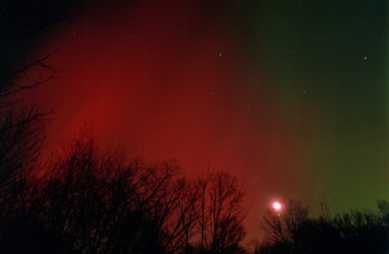 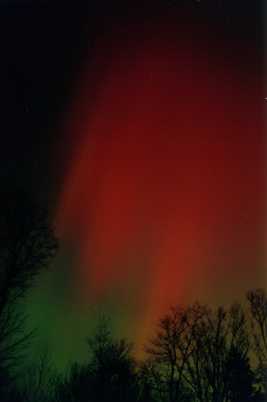 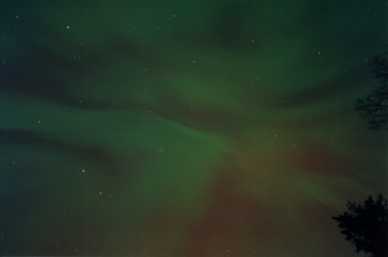 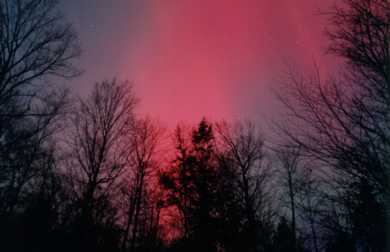 |
|
Attached are a few of my images of the November 5th auroras.
All the pictures were taken before midnight on the 5th. I was near a place called Carnarvon, Ontario (45 degrees Lat.). I used a Canon F1 camera and 24mm f/2.8 lense and average exposures of 30 seconds. I used a combination of 3 film types (200 Agfa, 400 Kodak and 800 Konica).
The reds and pinks were amazing! I have never seen such richness of colour at this latitude.
|
| stankiewiczr@cogeco.ca (Rick Stankiewicz) [4 Nov 01] |
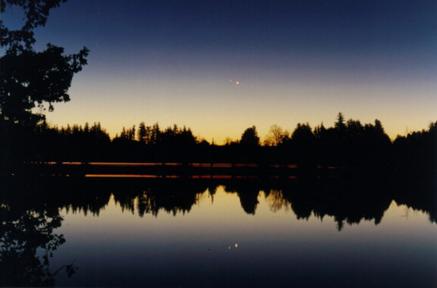 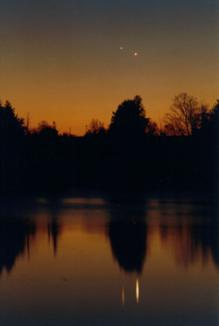 |
|
Please find attached the images I took of the November 3/01 conjunction of Mercury/Venus and Spica. It was a nice morning by the Otonobee River, but Spica proved to be a challenge to seen see, with the thin veil of cloud that crept in around sunrise.
All the images were taken with a Canon F1 camera, on Agfa HDC 200 ASA print film. These were all taken at the north end of Peterborough, Ontario, Canada, along the Otonobee River.
[Top] 30 October 2001 0550hrs - 50mm - f/8 - 8sec. (a car drove along the river [Bottom] 3 November 2001 0553hrs - 135mm - f/2.8 - 4sec. |
| dal@daliasgallery.com (D. M.) [04 Nov 01] |
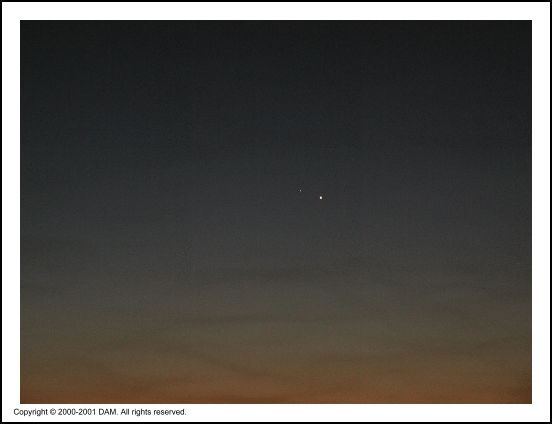 |
|
Today at dawn, I took a picture of Mercury and Venus using my digital camera, Olympus C3030 + 1.45 Teleconverter lens. The planets look like tiny dots but I think they're worth it. :)
Feel free to download the picture and put it on your site under "planets" section.
And thank you for putting up your site and keeping it updated. It's so informative. I almost visit your site daily as I have ETX-90EC. |
| gilsturgis@yahoo.com (Gil Sturgis) [29 Oct 01] |
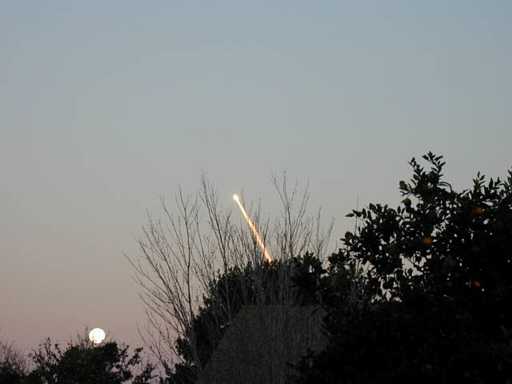 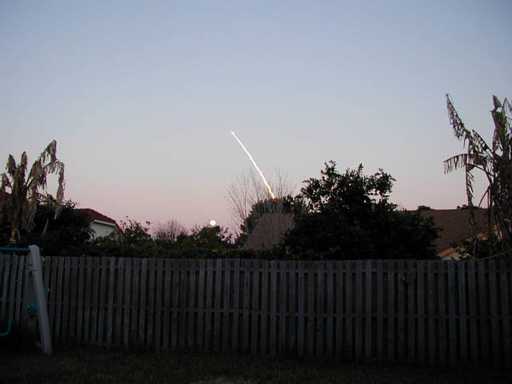 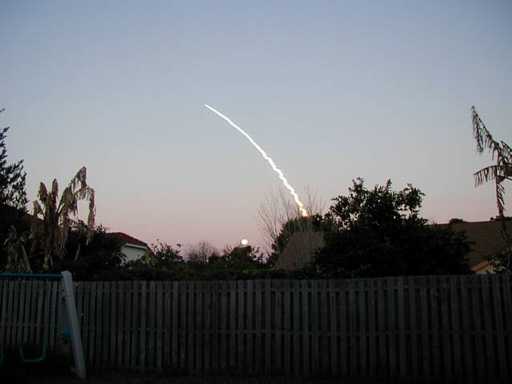 |
|
Here are some pictures of a shuttle launch this past
February with the full moon in the background taken
from my Orlando back yard that you may want to post in
the "Sky" section.
|
| kenariz@juno.com (Ken W Anderson) [16 Oct 01] |
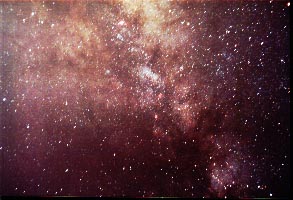 |
|
This was taken with a Russian Zenit piggybacking my ETX70EC.I was using A
44mm lens opened at F/2.8.
It is a 10 min exposure using ISO 800 fuji film. Let me know if im
mistaken but thats the Lagoon nebula. Although it might be upside down as
well.
|
| cmason@shentel.net (Chris Mason) [25 Sep 01] |
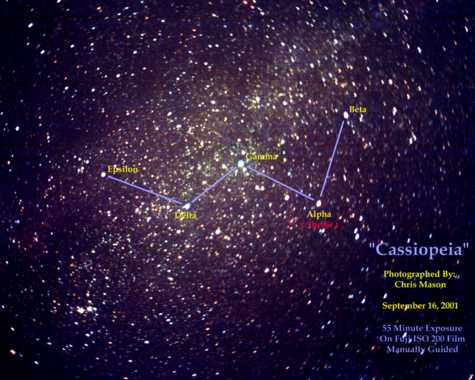 |
|
Here is a shot of Cassiopeia that I took using my Scopetronics piggyback mount I found out about on your page. I took it using a Pentax KX with 1:1.8/55mm lens. It is a 55 minute exposure on Fuji ISO 200 film, and manually guided using the autostar control pad. The method of guiding I used was to pick a guide star, and using high magnification I took the star out of focus until the blurred ring filled the field of view. Then when it drifted I made corrections. It was edited using Photoshop to improve contrast and depth. This is my first attempt at piggyback Photography, and I'm very happy with the results. I welcome any coments, and anyone who might know what caused the rotational effects that show up around the outer edges of the Cassiopeia pic, and how to prevent it in the future please E-mail me at cmason@shentel.net
I love the mighty ETX site, and it has helped me alot.
Mike here: The field rotation is most likely due to have the telescope mounted in Alt/Az mode. As the scope tracks the sky it is moving in two directions; you have to mount in Polar mode to avoid field rotation in long duration exposures. [Chris says it was mounted in Polar mode. See the continuing discussion on the September 2001 General Feedback page.]
|
| sgrijalva@yahoo.com (Saul Grijalva V.) [22 Sep 01] |
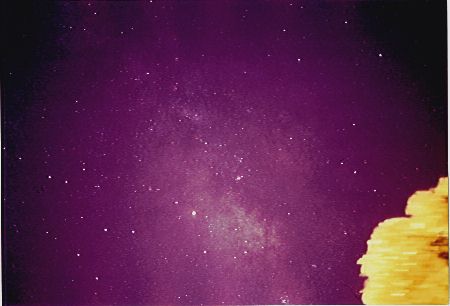 |
|
Here is a picture of the Milky Way I took from my backyard using a Minolta
camera with 50mm lens at f/1.2 piggybacked on my ETX-90. Exposure was
5minutes on Kodak color film ASA 800.
|
| stankiewiczr@home.com (Rick Stankiewicz) [4 Sep 01] |
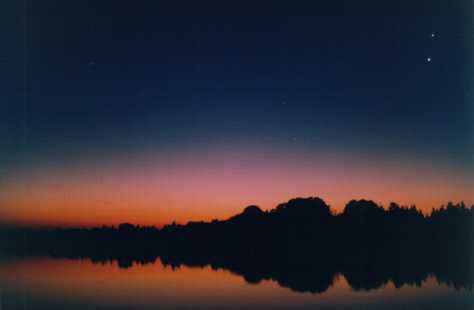 |
|
The following is an image of the August 8th Jupiter/Venus conjunction. They were less than 3 degrees apart. I captured this image along the Otonobee River just north of Peterborough, Ontario at 5:04 a.m. (EST). I used a Canon F1 35mm lense at f/3.5 for 8 seconds. I was using Konica Centuria 200 ASA print film too.
Note Pollux and Caster to the lower left.
|
| bill-rodger@home.com (Bill's Astronomy E-Mail) [10 Aug 01] |
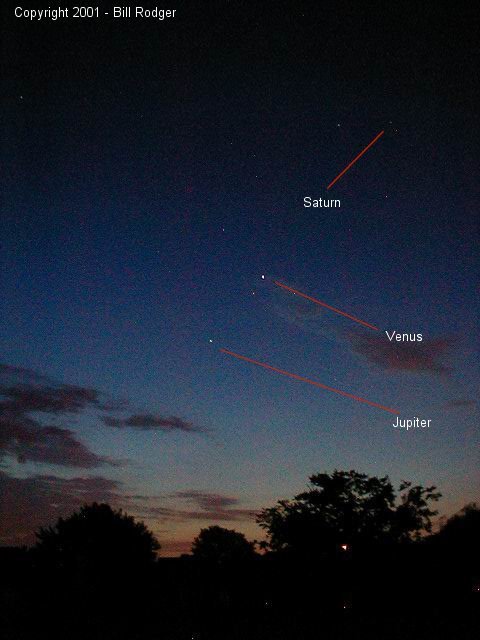 |
|
Here is a Photo taken to the East of North Ft Worth using Olympus 360DL Digital Camera at 4.45am
|
| stankiewiczr@home.com (Rick Stankiewicz) [26 Jul 01] |
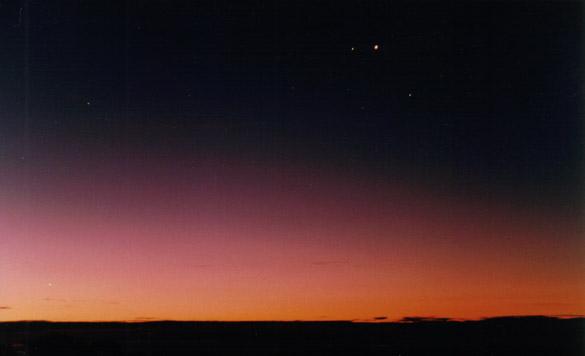 July 14/01 (0430hrs) Jup./Sat./Ven./Ald. - 60mm, f/3.5 @ 10sec. 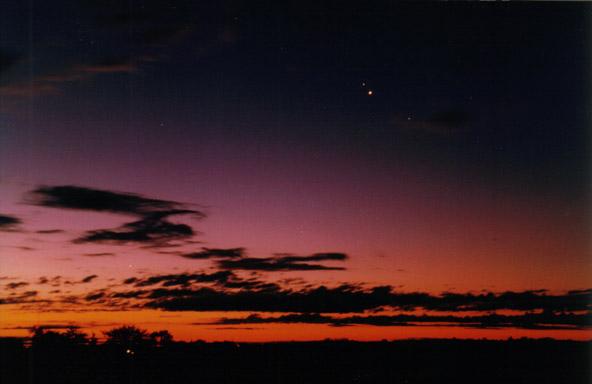 July 15/01 (0435hrs) Jup./Sat./Ven./Ald. - 50mm, f/3.5 @ 8sec. 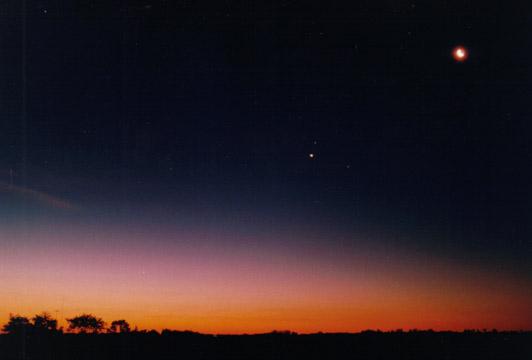 July 16/01 (0438hrs) Jup./Ven./Sat./Ald./Moon - 35mm, f/3.5 @ 4sec. |
|
All the above images were taken just east of Peterborough, Ontario, with a Canon F1 and Konica Centuria 200ASA colour print film.
|
| henrykzels@t-online.de (H. Zels) [3 Jun 01] |
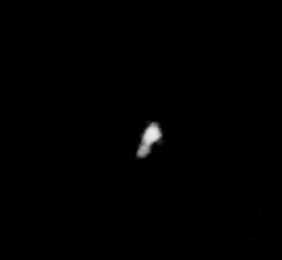 |
|
Maybe its a little late for that, but there was no time until now to rescan
and process some pictures taken about one week bevor the Mir crashed. The
Pics was taken through an etx90ec without the forkmount (mounted on a
Manfrotto Videohead as an spotting scope) at prime focus. Tracking was done
manually via a rubberband - mounted Telrad. Camera was Zenith312 at 1/30
second with Kodak TMax3200 (b&w negativ film).While the Mir was passing by i
took 10 pics. Four of them showed the Mir and i've stacked them with
astrostack. As i must say, i've seen better pictures of the Mir, but not
taken trough a etx90 (at least not with an ordinary camera) nor with a q&d -
setup like mine :)
|
| igrodroch@enlace.net (Ignacio Rodriguez) [5 May 01] |
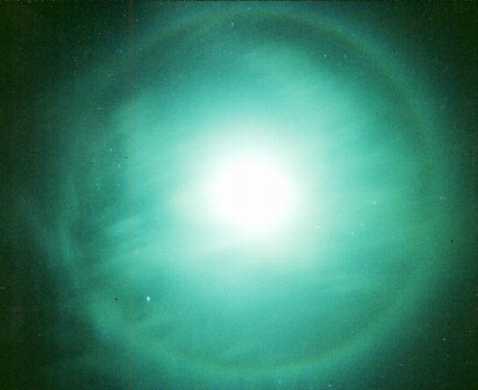 |
|
Last sunday I capture an intersting photo af a lunar halo. I've seen this several times but this one was big!
The photo was taken on April 27 ( 26.3N, 99.5W) at 11:00 pm. The halo diameter was 46, that is almost 100 moons in line !
The picture was taken with an Olympus OM2000 ,a Vivitar 24mm f/2.8 lens and Kodak ISO 800 film. Exposure time 90 seconds. You will see the moon overexposed and much more bigger, in fact what you will see is the overexposed effect of the moon. Supose the halo is a clock, As a reference in the picture Pollux and Castor are at 4 and Procyon is at 7 o'clock. There is also one end of hydra constelation at 9.
|
| stankiewiczr@home.com (Rick Stankiewicz) [28 Mar 01] |
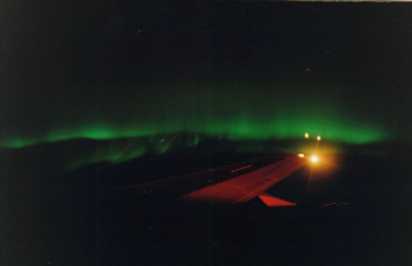 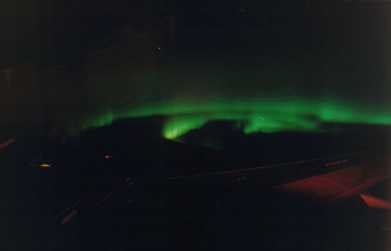 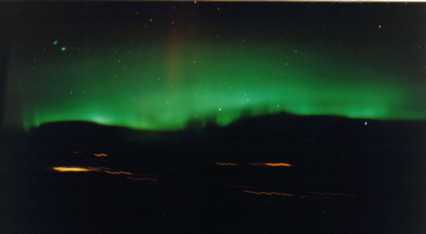 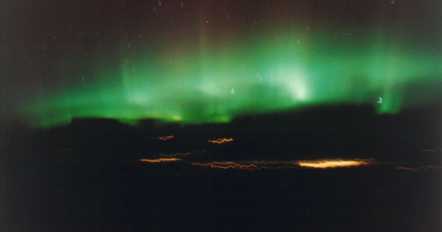 |
|
Hello, I just wanted to share with you a few images I captured on a flight from Hamilton, Ontario to Winnipeg, Manitoba, on March 20, 2001. I was flying with WestJet Airlines, in a Boeing 737, at about 500 mph. At about 9:30 p.m. (eastern) we were close to Thunder Bay, Ontario, when there appeared to be some aurora activity starting in the northern horizon. By 9:45 p.m., there was no doubt what was happening. The attached images, #1 and #2, were taken over the right wing tip of the aircraft.
At 10:00 p.m. I was invited up to the flight deck to see if I could get a few shots from up there. The pilots were very accommodating indeed. I was able to get images, #3 and #4 from behind the co-pilot's seat, looking out the rear right of the cockpit. The conditions were not ideal for taking pictures, but all things considered, I was pleased with the results.
All the attached images were taken on 200 ASA print film, using a Canon F1 camera and 24mm lense set at f/2.8. The exposures were around 30 seconds each. Faster film would have been nice, but you have to try what ever you can. I feel so blessed to have had this opportunity to see a display like this and to have at least had a chance to show you all some of the results.
Keep looking up (or down in this case),
|
| tompilot@zbzoom.net (Tom Surgalski) [24 Feb 01] |
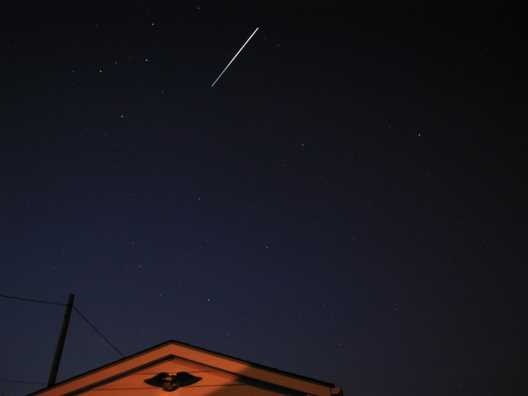 |
|
While technically not an ETX picture, here is a shot of the ISS streaking overhead. This was a ten second exposure with my Olympus 2020Z. I had the camera and ETX out to take some photos of Venus. I am sending you the original. Feel free to crop it as you need.
As always, thanks for your effort on this site.
|
| mlc@cisco.com (Mike Cellino) [24 Feb 01] |
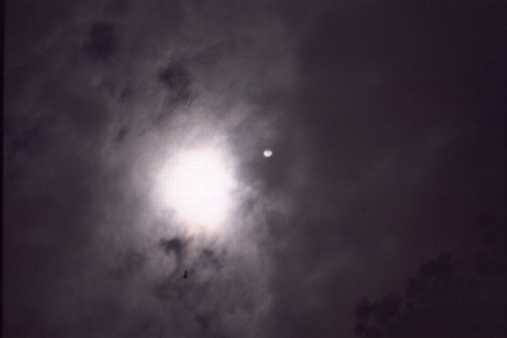 |
|
I just purchased an ETX125 a month ago. It is my third telescope in the
last 3 months (replacement/
upgrade), but I wish I had done a little research on your website before
my last purchase. I
have become interested in astrophotography and I'm finding out that this
is probably not the
correct scope for me. In any event, I need to echo the appreciation of
all the other readers
with thanks for such an informative site.
Anyhow, I have attached an interesting photo to look at though not taken
through an ETX. It is
of the moon on a cloudy night. The clouds where low and fast moving.
Camera was a Canon A-1,
with 50MM lens. Film - Kodak color slide, ASA 400, exposure 12
seconds. The small white
dot above and to the right of the moon was a reflection off the back of
the lens.
|
| henrykzels@t-online.de (H. Zels) [18 Feb 01] |
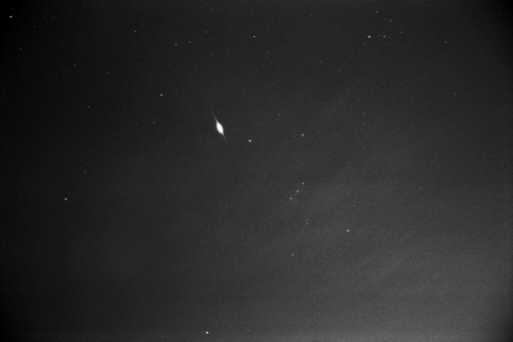 |
|
please find attached a picture of an iridiumflare. Although it's not really
a ETX - picture (the etx was standing nearby surrounded by lots of curious
peoples)i think it may fit in your guest gallery. The picture was taken with
a simple russian camera (zenith 312) equipped with an 28mm f2,8 lens
(M42-thread-lenses are a really bargain now). Exposure was about 30 seconds
on Kodak T-Max3200 (developed down to 400ASA to get the grainyness a little
out of the fast film). The background of the picture is a little bright
because the location is a parking lot in the city (Darmstadt). The picture
is adjusted to get the best between contrast and grain.
|
| henrykzels@t-online.de (Henry Zels) [21 Jan 01] |
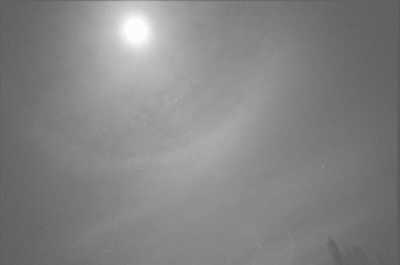 |
|
please find attached a picture of the moon (after the lunar eclipse
09.01.2001) showing a nice corona. The photo was taken with a 28 - 200 mm
Zoom - Lens at 28 mm f=3,5 (there are lots of vignetting in the edges of
the picture), KODAK T-MAX 3200 in Nikon F3 (automatic exposure).
|
See the Guest Sky Astrophotography Archive for photos posted in 2000.
See the Guest Sky Astrophotography Archive for earlier photos.
Return to the top of this page.
Go back to my ETX Home Page.